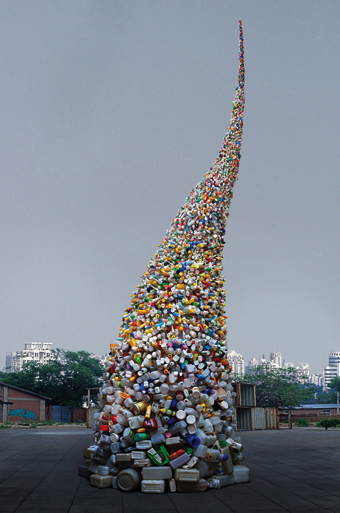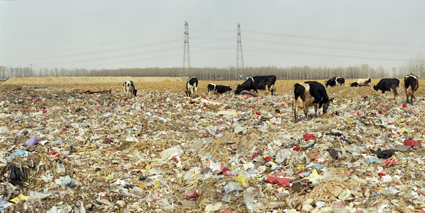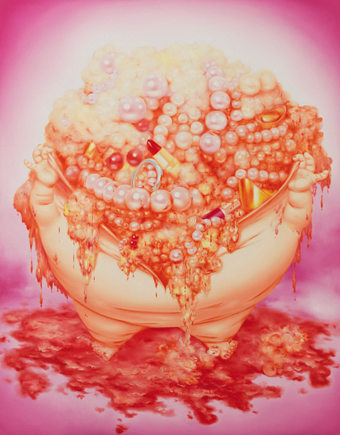 |
Wang Zhiyuan b. 1958, Tianjin Thrown to the Wind, 2010 steel, plastic photo courtesy of the artist and White Rabbit Gallery |
Here, The Big Bang refers to “the explosion of creativity that has rocked China since its 'Opening Up' to the global economy began in 2000.” This hyperbolic premise had me slightly apprehensive I might encounter an exhibition leveraging some of the now commonly hyped assertions characterising discussions of contemporary Chinese art, and in some respects this is what I found. But when the work is this good, concerns over how a show is marketed are best put to one side in favour of focusing on the art itself. Spread across four gallery floors, this eclectic presentation of works from over 35 artists had me enthralled for hours while also considering a broad array of questions around national versus personal identity, alienation in modern life, cultural amnesia and the role of history in present day China and beyond.
 |
Wang Jiuliang b.1977, Anqiu City, Shandong Beijing Besieged by Waste—Guanniufang Village, Xiaotangshan Township, Changping District 40°09'06" N, 116°22'14" E 2009 digital photograph photo courtesy of the artist and White Rabbit Gallery |
Wang Jiuliang's photojournalism, however, is not characteristic of the majority of The Big Bang artists who prefer to view life through a less literal and more expressionistic lens. Among the most intriguing examples are two mixed media works from multinational Shanghai based art collective, Liu Dao/island6, who work at the interface of art, computers and electronics while seeking to explore “the connections between dreams and waking consciousness.” In Shirt (2009) an LCD screen doubles as a mirror set within a black antique style frame, its surface scratched with finely cross-hatched black lines hinting at an act of vandalism. An infra-red sensor detects the presence of the viewer triggering the projection of an image of a woman onto the mirror/screen where she tries out various poses while dressed in an over-sized men's business shirt. A witty work, it is also unsettling in its subtle allusion to the voyeuristic impulse that can underscore art viewing and is compelling in its harnessing of technology to delve into the mysterious terrain of desire and the psyche.
The work of Liu Dao/island6 also bears further mention for the way its collective arrangement tests how permeable the boundaries of Chinese art might be. Founded by French artist and curator Thomas Charvériat, now based in Shanghai and drawing artistic collaborators from China, Europe, the US and further afield, this cross-cultural collaboration is certainly a healthy sign of the maturation of the art scene. Yet it also suggests the presentation of contemporary Chinese art may benefit from being geared around more conceptual or thematic lines allowing the work to enter into dialogue with other cultures rather than emphasising its intrinsic “Chinese-ness,” which has become a commodity. This is not to imply The Big Bang is focused on a fixed or historical idea of Chinese art. On the contrary, as its curators point out, much of this work comes from “wired and web-smart products of the one-child policy” who “if their works share a common theme, it is change. And if they have a common perspective, it is ziwo, 'I myself'.”
 |
Chen Fei b.1972, Miaoming, Guangdong Beyond Satisfaction 2006 No. 2, 2006 oil on canvas photo courtesy of the artist and White Rabbit Gallery |
Concluding the exhibition on the gallery's top floor is a sprawling sculptural installation from Beijing artist Li Hongbo, Paper (2010). Here the artist painstakingly cuts, folds and glues dense layers of brown paper into honeycomb configurations mutating a human figure into a boa constrictor-like form that threatens to engulf the entire space. Dubbed the “slinky man” it is arguably among such supremely confident large-scale sculptural works that The Big Bang really comes into its own. These works might be referred to as “statement pieces” and while some might scoff at the term it is important to remember this is a privately funded collection and as such it reflects an individual's taste and preferences. Given White Rabbit represents such an extraordinary gesture of philanthropic generosity, this does put up barriers to critique one wouldn't necessarily encounter in a public museum. Still, where the absence of red tape perhaps weakens the curatorial rigour it also loosens constraints, opening up other opportunities. For viewers, here is a chance to encounter a big, bold and exuberant collection clearly driven by a genuine passion for Chinese art and culture. Certainly the gallery's label of an “artistic supernova” appears a fitting one.
The Big Bang, White Rabbit Gallery, Sydney, Sept 3 2010–Jan 30 2011; www.whiterabbitcollection.org/
RealTime issue #98 Aug-Sept 2010 pg. web
© Ella Mudie; for permission to reproduce apply to [email protected]








 back
back